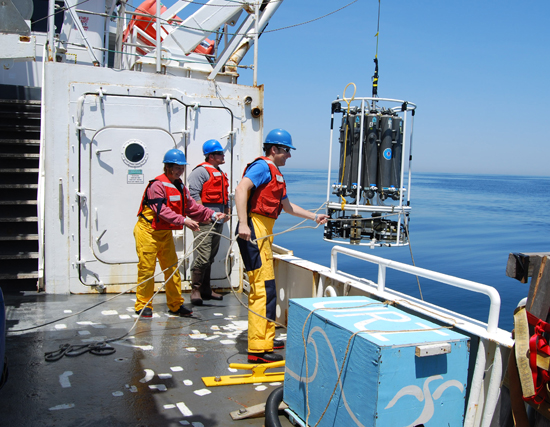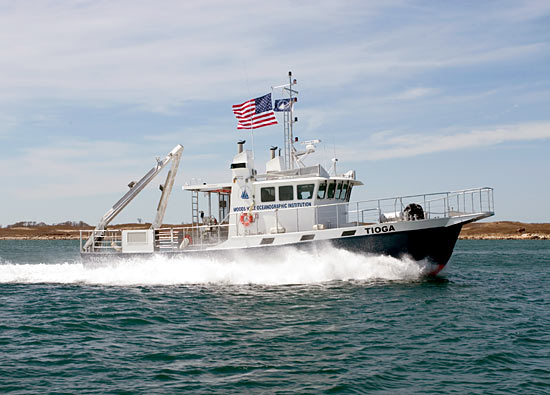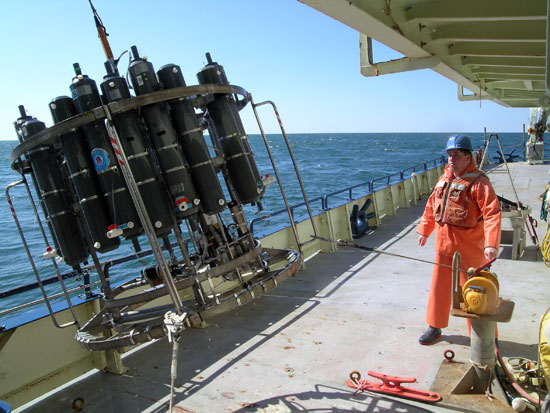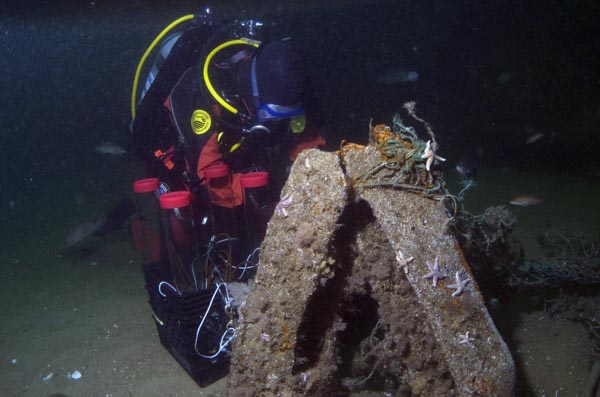GOMTOX
Dynamics of Alexandrium fundyense distributions in the Gulf of Maine
An observational and modeling study of nearshore and offshore shellfish toxicity, vertical toxin flux, and bloom dynamics in a complex shelf sea.
The Gulf of Maine (GoM) and its adjacent southern New England shelf is a vast region with extensive shellfish resources, large portions of which are frequently contaminated with paralytic shellfish poisoning (PSP) toxins produced by the dinoflagellate Alexandrium fundyense. The year 2005 was an historical one for A. fundyense and PSP dynamics in this area, with a bloom that was more severe than any seen in the last thirty years. There are significant challenges to the management of toxic shellfish in this region - in particular the need to document the major transport pathways for A. fundyense, and to develop an understanding of the relationship between blooms and environmental forcings, as well as linkages to toxicity patterns in nearshore and offshore shellfish. An additional challenge is to expand modeling and forecasting capabilities to include the entire region, and to transition these tools to operational, management use.
The overall objective of this project is to establish a comprehensive regional-scale understanding of Alexandrium fundyense dynamics, transport pathways, and associated shellfish toxicity and to use this information and relevant technologies to assist managers, regulators, and industry to fully exploit nearshore and offshore shellfish resources threatened by PSP, with appropriate safeguards for human health.
GOMTOX will utilize a combination of large-scale survey cruises, autonomous gliders, moored instruments and traps, drifters, satellite imagery and numerical models to:
- Investigate A. fundyense bloom dynamics and the pathways that link this organism to toxicity in both nearshore and offshore shellfish in the Gulf of Maine and southern New England shelf waters
- Investigate the vertical structure of A. fundyense blooms in the study region, emphasizing the distribution of cells, zooplankton fecal pellets, other vectors for toxin, and their linkage to toxicity in offshore shellfish
- Assess interannual to interdecadal variability in A. fundyense abundance and PSP toxicity
- Incorporate field observations into a suite of numerical models for hindcasting and forecasting applications
- Synthesize results and disseminate the information and technology, transitioning scientific and management tools to the regulatory community for operational use
Relevant Publications
Anderson, D.M., B.A. Keafer, D.J. McGillicuddy, M.J. Mickelson, K.E. Keay, P.S. Libby, J.P. Manning, C.A. Mayo, D.K. Whittaker, J.M. Hickey, R. He, D.R. Lynch, and K.W. Smith. 2005. Initial observations of the 2005 Alexandrium fundyense bloom in southern New England: General patterns and mechanisms. Deep-Sea Res. II 52(19-21): 2856-2876.
Anderson, D.M., B.A. Keafer, W.R. Geyer, R.P. Signell, and T.C. Loder. 2005. Toxic Alexandrium blooms in the western Gulf of Maine: The plume advection hypothesis revisited. Limnol. Oceanogr. 50(1): 328-345.
Anderson, D.M., C.A. Stock, B.A. Keafer, A. Bronzino Nelson, B. Thompson, D.J. 2005. McGillicuddy, M. Keller, P.A. Matrai, and J. Martin. Alexandrium fundyense cyst dynamics in the Gulf of Maine. Deep-Sea Res. II 52(19-21): 2522-2542.
Anderson, D.M., D.M. Kulis, B.A. Keafer, K.E. Gribble, R. Marin, and C.A. Scholin. 2005. Identification and enumeration of Alexandrium spp. from the Gulf of Maine using molecular probes. Deep-Sea Res. II 52(19-21): 2467-2490.
Keafer, B.A., J.H. Churchill, D.J. McGillicuddy, and D.M. Anderson. 2005. Bloom development and transport of toxic Alexandrium fundyense populations within a coastal plume in the Gulf of Maine. Deep-Sea Res. II 52(19-21): 2674-2697.
Additional Information
For more information on the GOMTOX project, including the full proposal and complete list of investigators, please follow the link below.
» GOMTOX



